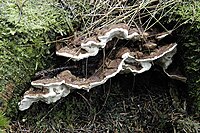
Are Eurosta solidaginis on Solidago rugosa a divergent host-associated race?
Sign Up to like & getrecommendations! Published in 2018 at "Evolutionary Ecology"
DOI: 10.1007/s10682-018-9966-z
Abstract: The ball-gall fly Eurosta solidaginis is considered a classic example of host-race formation in herbivorous insects, with host-associated races evolving at least twice, including the well-known pair on Solidago altissima and S. gigantea. Yet E.… read more here.
Keywords: rugosa; solidaginis; host associated; host ... See more keywords

Anti-migraine activity of freeze-dried latex obtained from Calotropis gigantea Linn
Sign Up to like & getrecommendations! Published in 2022 at "Environmental Science and Pollution Research"
DOI: 10.1007/s11356-021-17810-x
Abstract: Migraine which is characterized by a pulsating headache affected an estimated population of 12% worldwide. Herbal products like latex derived from Calotropis gigantea R. Br. (Asclepiadaceae) are a representative intervention to treat migraine traditionally. However,… read more here.
Keywords: gigantea; freeze; anti migraine; calotropis gigantea ... See more keywords

Natural infection and colonization of pre-commercially cut stumps of Picea abies and Pinus sylvestris by Heterobasidion rot and its biocontrol fungus Phlebiopsis gigantea
Sign Up to like & getrecommendations! Published in 2020 at "Biological Control"
DOI: 10.1016/j.biocontrol.2020.104208
Abstract: Abstract Fungi from the genus Heterobasidion are among the most important pathogens of forest trees in Northern Hemisphere causing root rot and wood decay, while Phlebiopsis gigantea is a very common saprotrophic wood decay fungus.… read more here.
Keywords: infection; gigantea; phlebiopsis gigantea; heterobasidion spp ... See more keywords

Diversity of the endophytic fungi associated with the ancient and narrowly endemic neotropical plant Vellozia gigantea from the endangered Brazilian rupestrian grasslands
Sign Up to like & getrecommendations! Published in 2017 at "Biochemical Systematics and Ecology"
DOI: 10.1016/j.bse.2017.02.006
Abstract: This study focused on the taxonomy and diversity of the endophytic fungi associated with Vellozia gigantea, an endemic, ancient, and endangered plant species that occurs only in the rupestrian grasslands of Brazil. A total of… read more here.
Keywords: fungi associated; diversity; endophytic fungi; diversity endophytic ... See more keywords

Supercritical carbon dioxide extraction of Solidago gigantea Ait.: Optimization at quarter-technical scale and scale up the process to half-technical plant
Sign Up to like & getrecommendations! Published in 2019 at "Industrial Crops and Products"
DOI: 10.1016/j.indcrop.2018.12.050
Abstract: Abstract Solidago gigantea Ait. (goldenrod) is widely spread in Poland and has a traditional usage as medicinal plant due to the content of bioactive compounds. The main aims of this research were to obtain the… read more here.
Keywords: gigantea; half technical; quarter technical; scale ... See more keywords

Metabolite profiling, anti-inflammatory, analgesic potentials of edible herb Colocasia gigantea and molecular docking study against COX-II enzyme.
Sign Up to like & getrecommendations! Published in 2021 at "Journal of ethnopharmacology"
DOI: 10.1016/j.jep.2021.114577
Abstract: ETHNOPHARMACOLOGICAL RELEVANCE Consumable herbs play a basic part in sustenance and human health. Traditionally, Colocasia gigantea Hook (Araceae) is used to treat fever, infection, wounds healing, drowsiness, tuberculosis, stomach problems etc. AIM OF THE STUDY:… read more here.
Keywords: anti inflammatory; study; edible herb; inflammatory analgesic ... See more keywords

Chemometric profile & antimicrobial activities of leaf extract of Calotropis procera and Calotropis gigantea
Sign Up to like & getrecommendations! Published in 2017 at "Natural Product Research"
DOI: 10.1080/14786419.2016.1266349
Abstract: Abstract Calotropis procera and Calotropis gigantea are medicinal plant having therapeutic value. The leaf extracts of C. procera have been investigated, its pharmacological actions in detail and leaf extracts of C. gigantea were not studied… read more here.
Keywords: calotropis; procera; procera calotropis; gigantea ... See more keywords

Genome Assembly and Analyses of the Macrofungus Macrocybe gigantea
Sign Up to like & getrecommendations! Published in 2021 at "BioMed Research International"
DOI: 10.1155/2021/6656365
Abstract: Macrocybe gigantea (M. gigantea) is a macrofungus genus that contains a big number of fairly fleshy gilled mushrooms with white spores. This macrofungus produces diverse bioactive compounds, antioxidants, and water-soluble polysaccharides. However, the genomic resources… read more here.
Keywords: macrocybe gigantea; analyses macrofungus; genome assembly; gigantea ... See more keywords

First molecular identification of Suillia gigantea (Meigen, 1830) (Diptera: Heleomyzidae).
Sign Up to like & getrecommendations! Published in 2023 at "Zootaxa"
DOI: 10.11646/zootaxa.5228.2.2
Abstract: In 2017, the presence of the fly Suillia gigantea (Meigen, 1830) was noted in Poland, after many years of research related to the ecology of insects associated with the fruiting bodies of hypogeous fungi. Finally,… read more here.
Keywords: gigantea meigen; suillia gigantea; diptera; meigen 1830 ... See more keywords

The larvae of Cora inca Selys, 1873 and Polythore gigantea (Selys, 1853) from Colombia (Odonata: Polythoridae), with a larval diagnoses of some genera in the family.
Sign Up to like & getrecommendations! Published in 2023 at "Zootaxa"
DOI: 10.11646/zootaxa.5254.4.4
Abstract: The larvae of Cora inca Selys, 1873 and Polythore gigantea (Selys, 1853) were found in first and second order forested streams at the Tatamá Natural National Park in the Colombian Western Andes. Their final larval… read more here.
Keywords: polythore; family; cora inca; selys 1853 ... See more keywords

Synthesis and Application of Carboxymethyl Cellulose from Gliricidia sepium and Cola gigantea
Sign Up to like & getrecommendations! Published in 2018 at "Bioresources"
DOI: 10.15376/biores.13.3.6077-6097
Abstract: Carboxymethyl cellulose (CMC) was prepared from Gliricidia sepium and Cola gigantea cellulose with yields of 1.59 g/g and 1.76 g/g, respectively. The pH of the products were weakly acidic (6.47 and 6.54, respectively). The sodium… read more here.
Keywords: gliricidia sepium; cmc; carboxymethyl cellulose; gigantea ... See more keywords